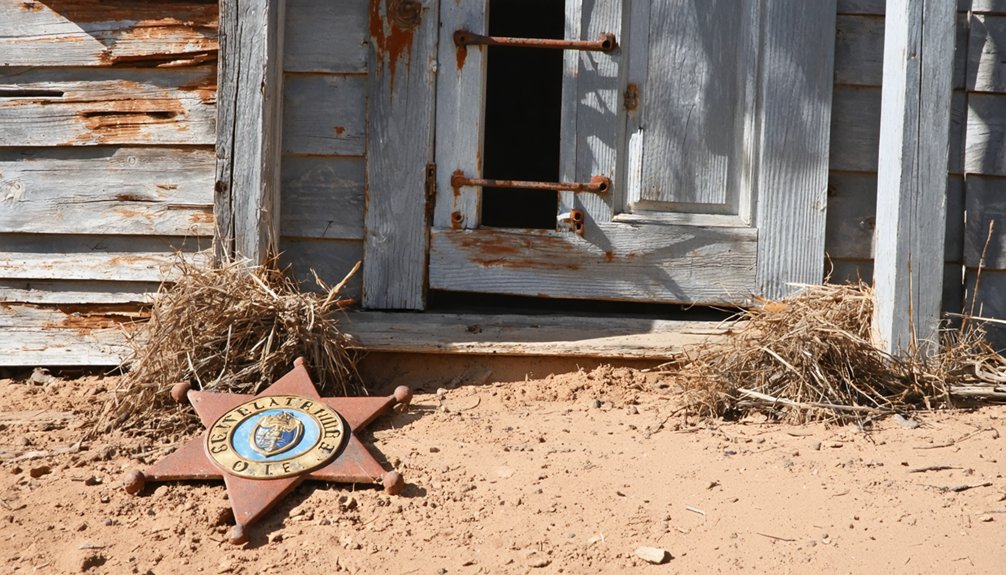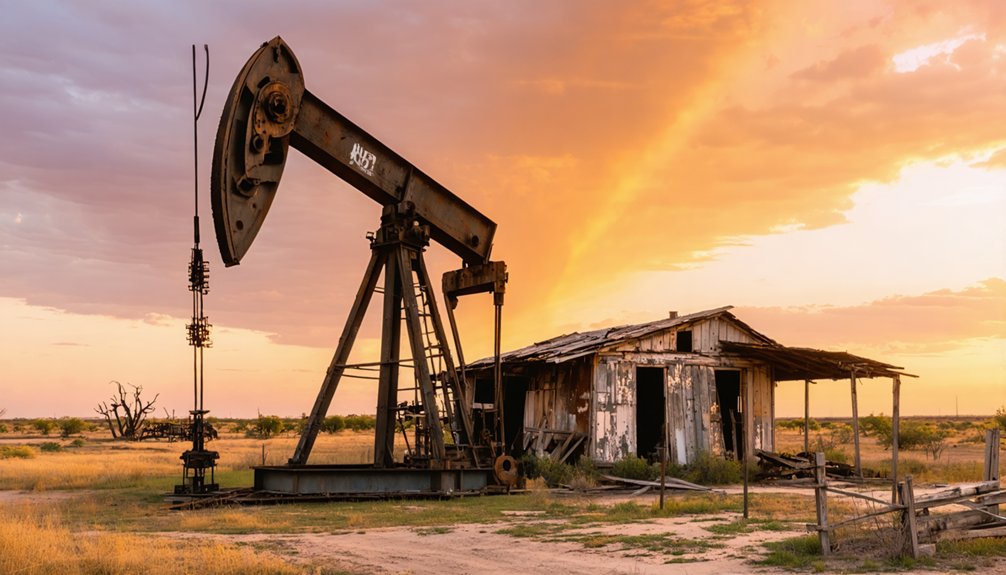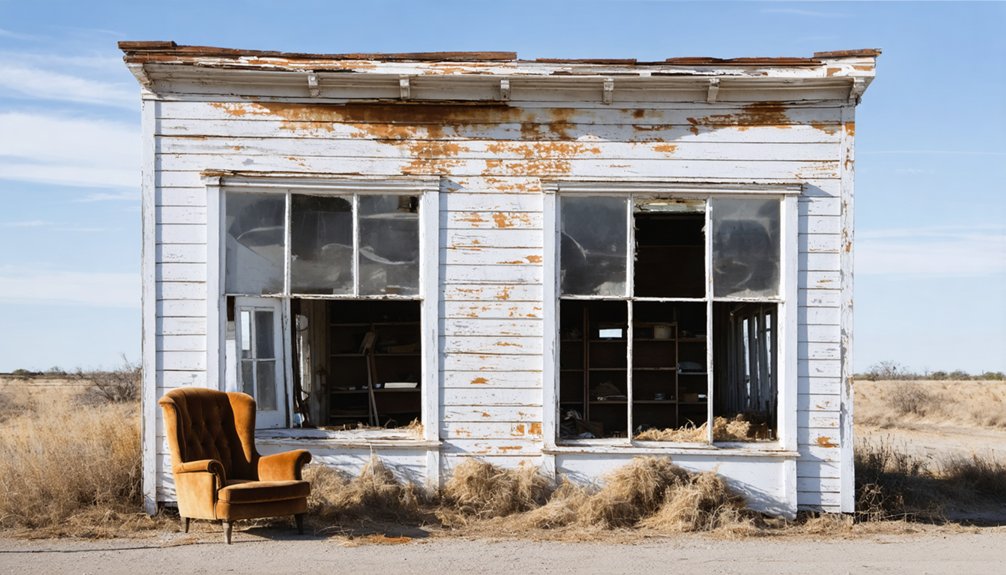You’ll find Desdemona in southeastern Eastland County, Texas, where a humble farming settlement of 340 residents exploded into a chaotic boomtown of 16,000 in 1918 after striking oil. The town’s wells produced over 7 million barrels at their peak, transforming the quiet peanut-farming community into a frontier metropolis overnight. When the oil dried up, most residents fled, leaving behind abandoned buildings, scattered oil derricks, and stories of Texas’ most dramatic boom-and-bust saga.
Key Takeaways
- Desdemona transformed from a 340-person farming community into a 16,000-resident boomtown after oil discovery in 1918, before rapidly declining.
- The town’s oil production peaked at 7 million barrels in 1919, but wells quickly dried up, leading to mass exodus.
- Modern Desdemona has only 180 residents, with most original buildings abandoned and its municipal government dissolved.
- The Hog Town General Store remains one of few active businesses, alongside approximately ninety operating oil wells.
- The town’s swift rise and fall exemplifies the boom-and-bust cycle common in Texas oil towns of the early 20th century.
From Humble Hogtown to Frontier Settlement
While many Texas frontier settlements emerged along the Brazos River, Desdemona began in 1857 as a humble family fort on C.C. Blair’s land.
In 1857, far from the bustling Brazos settlements, Desdemona took root as a simple fort built by C.C. Blair.
You’ll find this pioneering outpost tucked away in southeastern Eastland County, marking one of the oldest settlements west of the Brazos. The Hogtown origins stem from its location near Hog Creek, though the name later changed to honor a local justice of the peace’s daughter.
The settlement’s challenges didn’t stop the community from growing. By 1873, they’d established the Rockdale Baptist Church, and when William and Ben Funderburg acquired the fort’s land in 1875, development picked up pace. The discovery of oil in Tom D’s well in 1918 transformed the quiet town into a booming settlement.
Within two years, they’d secured a post office, cementing Desdemona’s place as a proper frontier town. The town flourished as a trading center, with its population reaching three hundred forty residents by 1904.
Life Before the Black Gold Rush
If you’d traveled to Desdemona in 1857, you’d have found pioneer families building Fort Blair near Hog Creek to protect themselves from Native American raids.
By the 1870s, you’d see the settlement transform from a frontier outpost into a small but established farming community, where peanut cultivation became the economic backbone. The community constructed a hewed log schoolhouse where local children would sit on benches made from split trees. Much like other small Texas communities, recording and sharing these local stories required community contributions to preserve their unique history.
The town’s modest growth continued steadily, reaching about 340 residents by 1904, with daily life centered around agricultural duties, church gatherings, and local social events.
Frontier Fort Life
As settler C.C. Blair established the largest far western family fort in 1857 near Desdemona, you’d find a remarkable example of frontier fort life taking shape.
The settlement featured 12 log cabins arranged in two parallel rows, with sturdy pickets filling the spaces between, creating a fortified sanctuary for pioneering families.
You’d witness remarkable community resilience as residents like the Blairs, Ellisons, and Gilberts shared defense duties and daily tasks.
Their survival depended on dangerous supply runs to the Brazos River settlements, where they’d procure precious ammunition and provisions. The settlers produced essential supplies within the fort, including candles, soap, and food staples.
Inside the fort’s protective walls, you’d see a tight-knit community adapting to the harsh realities of Texas frontier living, working together to maintain security and establish a foothold in this untamed territory. Just as Fort Worth had demonstrated in 1849, frontier forts were essential for protection against threats in the expanding West.
Peanut Farming Community
Three major events transformed Desdemona’s agricultural identity in the early 1900s: the devastating boll weevil infestation of 1906, the experimental peanut crop of 1907, and the establishment of a peanut mill by 1914.
You’d have witnessed local farmers adapting through agricultural diversification strategies, shifting from cotton to peanuts as their primary cash crop. By 1914, they were shipping 500 carloads of peanuts at sixty cents per bushel.
The community’s resilience showed in their peanut cultivation techniques, which evolved to include irrigation and artificial drying by mid-century. Much like the successful Peach & Melon Festival tradition in nearby De Leon, these agricultural innovations helped sustain the local economy.
The Texas Central Railroad arrival in 1881 provided crucial market access for local farmers. You’d have seen farmers hedging their bets with peach orchards, pecans, and substantial poultry operations. The town thrived, growing from 100 residents in 1892 to 340 by 1904, with a bustling agricultural economy that defined life before the oil boom.
The Day Oil Changed Everything
You’d hardly recognize sleepy Desdemona in September 1918 when oil gushed from a well at 2,000 barrels per day, transforming the quiet peanut-farming community into a bustling boomtown overnight.
Your small town of 340 residents suddenly burst at the seams as thousands of oil workers, speculators, and fortune seekers poured in, swelling the population to 16,000.
The black gold rush brought immediate wealth but also chaos, as crude oil overflowed storage tanks, polluted local waterways, and filled the air with the unmistakable smell of Texas tea. Once known as Hog Town, Desdemona’s transformation west of the Brazos River marked a defining moment in Texas oil history. Just like in nearby Ranger College, where academic integrity concerns emerged with the rapid changes, the town struggled to maintain order amid the explosive growth.
Striking Black Gold
The discovery of black gold transformed Desdemona’s destiny in September 1918 when Hog Creek Oil Company struck a gusher producing 2,000 barrels per day. This initial oil discovery sparked an unprecedented drilling boom that would reshape this small peanut-farming community forever.
Within months, the quiet hamlet of 340 residents exploded into a bustling boomtown of 16,000 people.
Key developments that followed:
- The oilfield expanded to 315 wells by 1922, averaging 4,000-6,000 barrels daily
- Production peaked in 1919 at over 7 million barrels
- The Merriman Baptist Church became known as America’s richest church due to oil revenues
You would’ve witnessed a town transformed overnight, as oil workers and speculators rushed in, though this prosperity wouldn’t last beyond 1922.
Boom Town Overnight
When news of Hog Creek’s gusher spread in September 1918, a tidal wave of fortune seekers descended upon Desdemona, transforming this sleepy farming village into a booming oil town practically overnight.
You’d hardly recognize the once-quiet community of 340 residents as thousands poured in, seeking their piece of Texas black gold. Oil exploration companies sprouted up everywhere, while economic speculation drove land prices through the roof.
The landscape changed dramatically as new housing, schools, and businesses emerged to support the surging population.
You could witness the transformation daily – drilling operations dotted the horizon, refineries and transport facilities materialized, and merchant services expanded rapidly.
The farming economy you once knew vanished, replaced by an oil-driven frenzy that turned modest properties into valuable assets and forever altered Desdemona’s destiny.
When 16,000 People Called Desdemona Home
During 1918, black gold transformed sleepy Desdemona into a bustling boomtown after oil was discovered nearby. The population dynamics shifted dramatically as workers flooded in, swelling the town to 16,000 residents by 1919.
The economic impact reshaped daily life as oil replaced farming, bringing unprecedented prosperity and challenges to the small Texas community.
- You’d have witnessed the town’s rapid transformation from quiet agricultural life to a 24/7 operation with makeshift housing camps and crowded streets.
- You’d have seen new businesses spring up overnight – general stores, eateries, and entertainment venues catering to the oil workers.
- You’d have experienced the strain on basic services, prompting the construction of a small jail and hasty infrastructure expansion.
These changes marked Desdemona’s brief but intense period as a major oil town.
Law, Order, and Social Upheaval

As Desdemona’s population exploded from 340 to 16,000 residents in 1918-1919, lawlessness gripped the once-peaceful farming town.
Gambling dens, bootleggers, and brothels flourished while violent crime surged amid the chaos of the oil boom. You’d have witnessed concerned citizens forming the “Law and Order League” in a desperate attempt to restore peace, but their efforts proved futile against the tide of vice and disorder.
The Texas Rangers finally stepped in during 1920, cracking down on illegal activities and establishing control over the volatile situation.
Behind the scenes, social tensions simmered as the Ku Klux Klan gained influence, while political movements emerged from economic discontent.
The Rangers’ intervention brought temporary stability, though deeper issues of racial conflict and social upheaval continued to challenge law enforcement efforts.
The Fleeting Fortune of a Boomtown
The transformation of Desdemona from a quiet farming settlement to an explosive oil boomtown mirrors the classic Texas tale of sudden wealth and swift decline.
You’d have witnessed a dramatic surge as oil discoveries in 1918 turned this modest farming community into a hub of economic volatility, where fortunes were made and lost overnight.
- Your chances of striking it rich skyrocketed as speculators and workers flooded the area, driving the population from 340 to thousands.
- You’d have seen oil derricks dominate the landscape while businesses multiplied to serve the booming workforce.
- Your window of opportunity closed quickly as wells dried up, leading to mass exodus and ghost town status.
This rapid rise and fall showcases how quickly the Texas oil boom could transform – and abandon – a community.
What Remains of Texas’ Lost Oil Empire

Modern-day Desdemona stands as a stark reminder of Texas’ fleeting oil empire, where you’ll find just 180 residents and a handful of businesses like the Hog Town General Store inhabiting what was once a bustling boomtown.
The oil legacy lives on through roughly ninety active wells and a Mobil butane plant, but they’re mere echoes of the region’s 1919 peak when seven million barrels flowed annually.
From millions of barrels to mere dozens of wells, Desdemona’s oil fields whisper stories of Texas’ faded petroleum glory.
You can trace the community decline through shuttered landmarks – the Lone Star Hotel burned in 1921, the public school closed in 1969, and the town’s municipal government dissolved in 1936.
What began as an agricultural settlement, transformed by black gold, has come full circle. Yet despite the exodus that followed the boom’s collapse, Desdemona’s remaining residents maintain their foothold in this monument to Texas’ oil history.
Frequently Asked Questions
What Was the Average Daily Oil Production During Desdemona’s Peak Years?
You’ll find oil production averaged roughly 19,000 barrels daily during the 1919 peak, creating massive economic impact when calculated from the year’s 7 million barrel total output.
Are There Any Remaining Oil Wells Still Operating in Desdemona Today?
You’ll find a few operational oil wells in the area, with current production reaching about 128 barrels of oil and 2,900 MCF of gas as of May 2025, showing limited but active status.
Which Oil Companies Were the Major Players During Desdemona’s Boom Period?
You’ll find Mobil and Pilgrim Oil Company led the oil exploration charge, with fierce corporate competition from numerous smaller operators who collectively produced over seven million barrels during the 1918-1919 peak period.
How Much Did Land Prices Increase During the 1918 Oil Rush?
Like a gold rush fever, you’d have seen land prices skyrocket during the 1918 oil boom, with rampant land speculation driving values from just dollars per acre to thousands overnight, creating massive economic impact.
What Happened to the Native American Tribes Originally Living in the Area?
You’ll find that Native heritage was systematically erased as Comanches, Apaches, and Kiowas faced tribal displacement through warfare, disease, and forced relocation to Oklahoma reservations by the 1870s.
References
- https://www.tshaonline.org/handbook/entries/desdemona-tx
- http://www.tsl.texas.gov/exhibits/railroad/oil/desdemona.html
- https://www.youtube.com/watch?v=uOqdJ-0dsew
- https://en.wikipedia.org/wiki/List_of_ghost_towns_in_Texas
- https://www.texasescapes.com/ClayCoppedge/Desdemona.htm
- https://www.texasescapes.com/TexasGhostTowns/Desdemona-Texas.htm
- https://kids.kiddle.co/Desdemona
- https://www.historictexas.net/city/desdemona-texas
- https://www.tshaonline.org/handbook/online/articles/hvhaf
- https://www.hmdb.org/results.asp??Search=Place&Town=Desdemona&State=Texas



